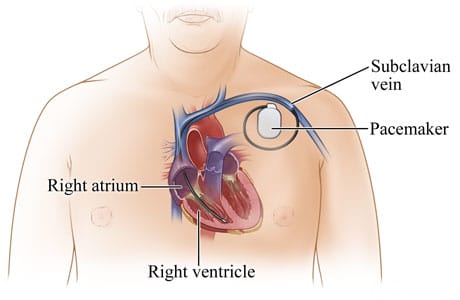Patient Education
Our Health Library information does not replace the advice of a doctor. Please be advised that this information is made available to assist our patients to learn more about their health. Our providers may not see and/or treat all topics found herein.
Permanent pacemaker

A pacemaker is a small, battery-powered device that sends out small electrical impulses to make the heart beat in a regular rhythm and at a normal speed. A pacemaker consists of a pulse generator and battery that create the electrical impulses. Most pacemakers have wires (leads) that transmit electricity to the heart. A pacemaker has one or more leads. A lead goes from the pacemaker through the subclavian vein and into a heart chamber, such as the right atrium or right ventricle. The end of the lead is in the heart chamber to stimulate the muscle.
A permanent pacemaker is typically placed under the skin of the chest. One type of permanent pacemaker is placed inside the heart. This type does not have leads.
Current as of: October 2, 2025
Author: Ignite Healthwise, LLC Staff
Clinical Review Board
All Ignite Healthwise, LLC education is reviewed by a team that includes physicians, nurses, advanced practitioners, registered dieticians, and other healthcare professionals.
This information does not replace the advice of a doctor. Ignite Healthwise, LLC disclaims any warranty or liability for your use of this information. Your use of this information means that you agree to the Terms of Use and Privacy Policy. Learn how we develop our content.
To learn more about Ignite Healthwise, LLC, visit webmdignite.com.
© 2024-2025 Ignite Healthwise, LLC.


